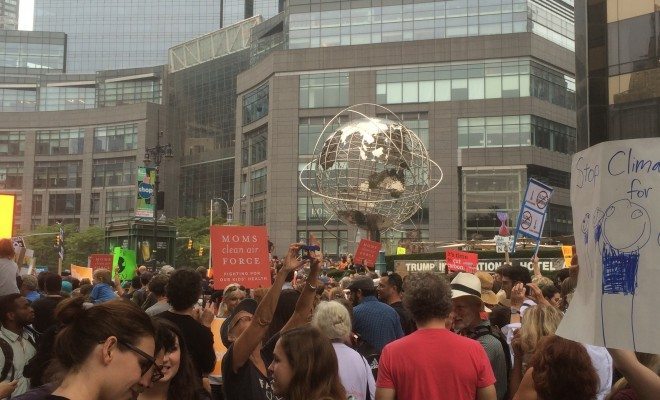
Blogs
Climate Change Unites World Community Across All Spectrums
Standing in the middle of a crushing crowd of people can be quite stressful, but this time it was worth it. The United Nations General Assembly spent the final week of September in session and one of the primary items of concern on its agenda is climate change and the environment, addressed in the form of the Climate Summit on Tuesday, September 23. On September 21, an astounding 400,000 people marched through the streets of Manhattan to vocalize the necessity of addressing climatic and environmental concerns.
In the largest environmental rally in history, activists began lining up earlier than 9:00am at designated locations from 59th street as high as 86th street. They organized under a variety of banners, from environmental organizations, scientists, private citizens, and more. It was under this final group that I started the march. It contained sub groups as well; there were community organizations, college students, and others. I am proud to note that a group representing my alma mater Rutgers University was among the most vocal in the area.
Reminiscent of how a car at the back of a long lineup will probably not make the light when it turns green because everybody hits the gas one at a time, my section of the four-mile long rally did not start marching until 45 minutes after the event was set to begin. It was very exciting once we did begin to move, and a surge of energy rolled through the crowd. However the density of the crowd meant that we moved like an inchworm; the line would stretch and we moved forward a little, but then compacted again and we stood in place for a bit. Eventually the line spread out and the walk became more consistent.
It was still quite slow going though, so eventually I exited the group and walked alongside on the sidewalk. As I was moving faster than the line, I was able to advance through the march and see all the different sections. There was no repetitiveness to the line’s appearance. Each group had its own chants and jingles, instrumental support, and occasional matching t-shirts. A migrant women’s workers rights group even performed a series of dances as they made their way down the street.
At 12:58pm the march stopped dead in its tracks for a moment of silence in honor of those who have been lost to climate crises. The huge crowd, moving and making noise for an hour and a half, was still and silent with hands to the sky. It was a powerful moment. I’m not sure from which direction it came, but the moment of silence was ended by a wave of shouts that rolled through the entire length of the line. The ultimate call to action had been sounded, and the march resumed with great vigor and enthusiasm.
Despite the motion and noise, music and megaphones, others took part in the call to action in different ways. Among the most striking was the Earth Vigil, a group sitting silent and meditative at the edge of Central Park. There are many ways for people of diverse backgrounds to express concerns over shared fates.
It is this detail that really struck me throughout the march. The health of the environment and fate of the planet are issues that span every economic class, race, orientation, and geography. The sheer variety of people merging voices over a common cause speaks to the urgency of the challenges we face and the importance of addressing them effectively. Environmental activism has tended to be viewed as an activity of the middle and upper classes who have the wealth and leisure to dedicate their energies to this more abstract set of problems. The Climate March proved otherwise. Every level of society is aware, concerned, and willing to act. Furthermore, every level of society is affected by environmental woes; its consequences are real and tangible, not an abstract, theoretical, “out there” set of problems.
The rally in New York City was the most notable, but other cities throughout the world held their own rallies on this day and throughout the week as well. Twenty-six hundred events in over 150 countries, in fact. This further indicates the global awareness and importance of climate and environment. Before the event began, I had an interesting conversation with a Climate March surveyor of Nigerian origin. He explained how China has been buying up land there for agricultural and mining purposes, inflicting horrific environmental damage in the process. The locals there tend not to understand the consequences, and further are often excited about the Chinese presence in hopes of generating revenue and raising the standard of living. However, as the surveyor detailed, these activities are channeled to benefit the Chinese economy and industry only; locals are left no better off from it. He feels that this and other rallies around the world will help raise awareness of this, among many problems. The key is not just making a loud statement to global leaders, but spreading knowledge to all people.
We should come away from this event with great optimism. It demonstrated that more and more people are aware of these problems, and are willing to act in order to solve them. The people are not willing to continue down this path; society has reached a turning point and a new era of knowledge and responsibility is beginning. Whether that be on an individual, communal, national, or global level, the power to make change is growing.
—
Franklin R. Halprin (@FHalprin) holds an MA in History & Environmental Politics from Rutgers University where he studied human-environmental relationships and settlement patterns in the nineteenth century Southwest. His research focuses on the influences of social and cultural factors on the development of environmental policy. Contact Frank at staff@LawStreetMedia.com.
Featured image courtesy of [Franklin R. Halprin]












Comments